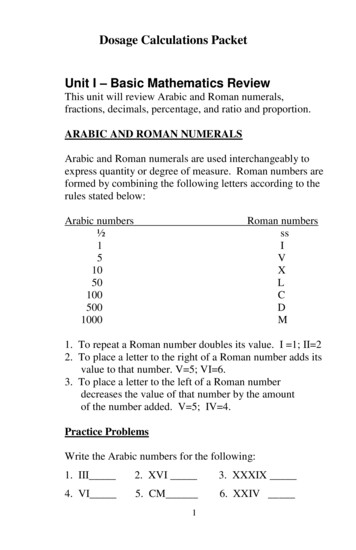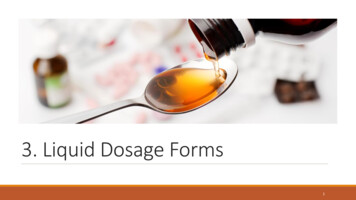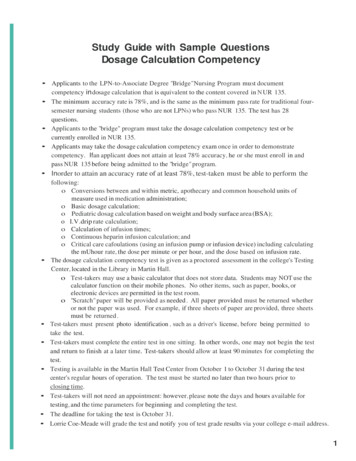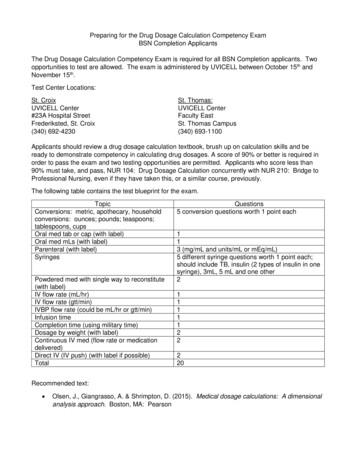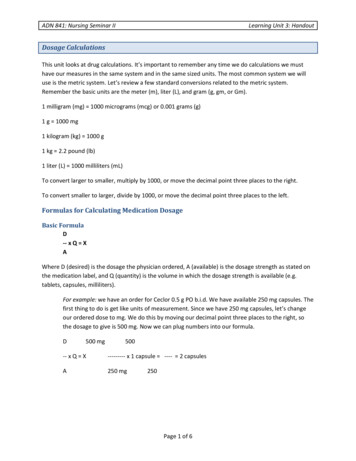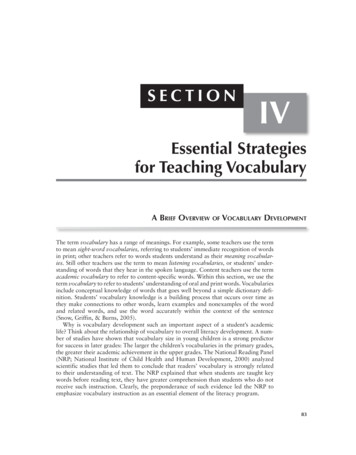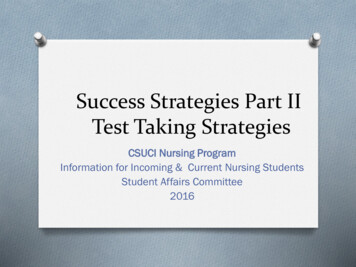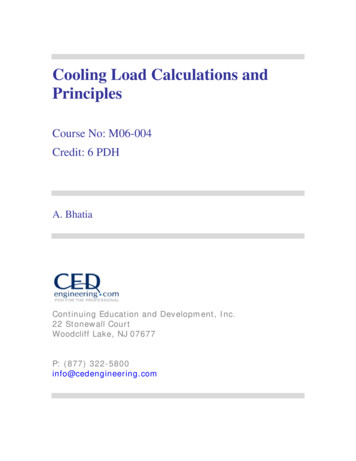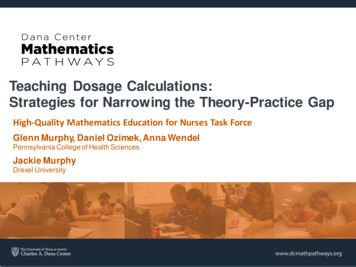
Transcription
Teaching Dosage Calculations:Strategies for Narrowing the Theory-Practice GapHigh-Quality Mathematics Education for Nurses Task ForceGlenn Murphy, Daniel Ozimek, Anna WendelPennsylvania College of Health SciencesJackie MurphyDrexel University
About Today’s DiscussionObjectives Discuss the unique challenges of teaching dosage calculations. Identify specific strategies for adapting classic dosage calculationproblems to actively engage learners. Describe the role of simulation and lab activities in narrowing thetheory-practice gap and supporting diverse learners. Connect with other educators dedicated to improvingmathematics education for nurses.Please use the chat to share your thoughts and reflections2
What Is A “Dosage Calculation”?Order: 500 mg IbuprofenAvailable: 250 mg / 1 tabletCalculate the amount to administer.Order: 1 L NS over 4 hoursThe available tubing has a drop factor of25 gtt/mL.Calculate the appropriate gtt/min flow rate.An infant who weighs 7 pounds and 4 ounces has an order for digoxin solution,49.5 mcg, oral, every 12 hours.The drug reference states that a safe dosage range is 6-10 mcg/kg/ dose oral dailyin 2 divided doses. Digoxin solution contains 0.05 mg/ 1 mL.What is the minimum recommended dosage range for this child per dose?Round to the nearest tenth.
Why Is This Discussion So Important?Over 7,000 deaths annually are attributed specifically tomedication errors(IOM, 2000)Only 19% of incoming nursing students passed acompetency test that assessed basic math abilities,including arithmetic, decimals, SI units, and fractions(Harvey et al., 2010)Only 55% of practicing nurses passed a basic numeracy test(McMullan, Jones, & Lea, 2010)4
Have You Heard This Before?“I calculated that thepatient needs to receive110 mL of morphine”“The appropriate rateto set is 45.8 gtt/mL”“I will set the IV pumpto 0.00578 mL/hr”5
The Uniqueness of Dosage CalculationsA conceptual model for medication dosagecalculation competency (Weeks et al., 2013)6
The Uniqueness of Dosage CalculationsA conceptual model for medication dosagecalculation competency (Weeks et al., 2013)1-Minute Think and Share1. Which “competency” doyou see students having themost trouble with?2. Do you tend to focus yourteaching on any“competency” in particular?7
What Do We Know From the Literature?Conceptual errors are most common(Blais & Bath, 1992; Fleming, Brady, & Malone, 2011)The mathematics skills and concepts learned in a classroomsetting tend to be very different then those actually applied inpractice (i.e. Theory-Practice Gap)(Dyjur, Rankin, & Lane, 2011; Marks et al., 2015; Wright, 2012)“For learning with understanding to occur, [mathematics] instruction needs toprovide students the opportunity to develop productive relationships, extendand apply their knowledge, reflect about their experiences, articulate whatthey know, and make knowledge their own”(Carpenter & Lehrer, 1999)8
What Does This Mean for Educators?Select tasks that are engaging, incorporate disciplinebased content, and provide opportunities to buildconnections.(Abell et al., 2019; Wright, 2012)Support development of mathematical proficiencythrough active learning, reasoning, and application ofreal-world skills.(AMATYC, 2018; Murphy & Murphy, 2019)9
A Classic Dosage Calculation ProblemA 4-week-old infant weighing 8 pounds, 12 ounces is admitted forfever.The provider orders acetaminophen 15mg/kg PO q4h prn fever.Acetaminophen is available as 160mg/5mL.How many mL will the nurse administer?How could this task be modified to be more “authentic”?10
A Classic Dosage Calculation ProblemA 4-week-old infant weighing 8pounds, 12 ounces is admitted forfever.The provider orders acetaminophen15mg/kg PO q4h prn fever.Acetaminophen is available as160mg/5mL.How many mL will the nurseadminister?11
A Classic Dosage Calculation ProblemA 4-week-old infant weighing 8pounds, 12 ounces is admitted forfever.The provider orders acetaminophen15mg/kg PO q4h prn fever.Acetaminophen is available as160mg/5mL.How many mL will the nurseadminister?12
A Classic Problem – ReconceptualizedAvailable MedicationsCalculate the appropriate amount ofacetaminophen to administer to Ana13
A Classic IV Rate CalculationCeftriaxone 2 g q12h is ordered.The infusion time is 30 minutes.Ceftriaxone is available at a strength of 2000 mg per50 mL.What mL/hr rate is needed to set an IV pump?
A Classic IV Rate CalculationCeftriaxone 2 g q12h isordered.The infusion time is 30minutes.Ceftriaxone is available at astrength of 2000 mg per 50mL.Medicationsazithromycin1000 mg poCeftriaxone2 g IV q12hStart 12/14/2019 0915End 12/14/2019 0945
A Classic IV Rate CalculationCeftriaxone 2 g q12h is ordered.The infusion time is 30 minutes.Ceftriaxone is available at astrength of 2000 mg per 50 mL.
A Classic IV Rate CalculationPROGRAMRateGiven the order andavailablemedication,determine how youwould set the pump.VTBI. mL/hrmLDuration : hr:minMedication OrdersAzithromycin1000 mg poCeftriaxone2 g IV q12hStart 12/14/2019 0915End 12/14/2019 0945
A Classic gtt/min IV CalculationA patient is ordered to receive 500 mL of NS over 90minutes. The drop factor is 10 gtt/mL. Calculate thegtt/min drip rate.
A Classic gtt/min IV CalculationA patient is ordered to receive 500 mL of NS over 90minutes. The drop factor is 10 gtt/mL. Calculate thegtt/min drip rate.1-Minute Think and Share1. What artifacts and processes could be includedin this problem to make it more engaging?2. How might this problem be modified to promptreflection on the underlying concepts?
A Classic gtt/min IV Calculation -- Prompt ReflectionORDER: Infuse 500 mL NS over 90minutes.The available CLEARLINK primarytubing is provided.
A Classic gtt/min IV Calculation -- Prompt ReflectionORDER: Infuse 500 mL NS over 90minutes.The available CLEARLINK primarytubing is provided.Given the IV set ups (Bag A, Bag Band accompanying chambers) on theright, which flow rate more-closelyaligns with the rate needed tocomplete the order above. Explain.BAGABAGB
One Last Example: Injection CalculationYour patient, Brendan Garcia, weighs 14.9 kg.Order: 0.5 mg/kg ketorolac (Toradol) injection Q6H prnAvailable: ketorolac (Toradol) 30 mg/mLCalculate the mL dose to administer.
One Last Example: Injection CalculationYour patient, Brendan Garcia, weighs 14.9 kg.Order: 0.5 mg/kg ketorolac (Toradol) injection Q6H prnAvailable: ketorolac (Toradol) 30 mg/mLWhich syringe is needed to complete this order? How doyou know?Syringes: Timothy W Ford [CC BY-SA 3.0https://commons.wikimedia.org/wiki/Category:SVG /3.0
Work individually to confirm and prepare theappropriate amount.Confirm your work with a partner.Discuss any differences you mighthave in your thinking and calculations.
What is missing in all of these tasks ?“[Incorporating multimedia and artifacts] lack the access toresources (pharmacists, nursing colleagues and reference tools)that are often available in the real-life setting. Despite attempts tocontextualize them, [assessments and tasks] are isolated fromembodied reality and the sights, sounds, smells, and other cuesthat place the nurse in the everyday world of practice”(Dyjur, Rankin, & Lane, 2011; p. 206)
What is missing in all of these tasks ?“[Incorporating multimedia and artifacts] lack the access toresources (pharmacists, nursing colleagues and reference tools)that are often available in the real-life setting. Despite attempts tocontextualize them, [assessments and tasks] are isolated fromembodied reality and the sights, sounds, smells, and other cuesthat place the nurse in the everyday world of practice”(Dyjur, Rankin, & Lane, 2011; p. 206)Simulation and Lab Activities!
Additional Skills for Safe Medication AdministrationNurses need to: Understand when calculations areneededKnow what needs to be discoveredComplete the calculation usingcorrect methodsEvaluate to make sense of answerAdminister using correct equipmentwith correct technique
Authentic Lab and Simulation ActivitiesDesign Simulation labSkills stationsGroups of 8 CalculationsMedication ordersEHR of primary clinical siteWeight-based calculations Hospital equipment/ policiesPractical mathematicsAdministration
Authentic Lab and Simulation ActivitiesKey elements of pediatric math calculations Safe dosage rangesIV fluid volumes/ ratesMedication volumesWeight conversions Oral suspension preparationIV infusion pump programmingInjectionsNasogastric tubePsychomotor skills for med administration
Authentic Lab and Simulation Activities
Authentic Lab and Simulation ActivitiesStudent Feedback “Helped me critically think, more applicable”“This is how medication administration is;distractions are present”“It makes you have to think; you have tothink of the solution and if it makes sensenot just how to solve the problem.”“This makes it make sense, you can see whyyou perform steps in math problems.”“The environment is much less threatening;you feel like you can ask questions.”
Suggestions for Implementing these IdeasCollaborate with colleagues outside yourdepartment.Work with your colleagues to create a databaseof artifacts.Contact us for access to our materials.
Stay Connected and Participate!Join the task force!http://bit.ly/QSENMathTaskForceLearn more about the Mathematics Education forNurses National Initiative from our r-education/collaborations/math-for-nurses
Questions?
Contact UsAnna Wendelawendel2@pacollege.eduJackie Murphyjm532@drexel.eduDaniel Ozimekdozimek2@pacollege.eduGlenn Murphygpmurphy@pacollege.edu
ReferencesAbell, M. A., Braddy, L., Ensley, D., Lewis, L., & Soto, H. (2018). MAA instructional practices guide. Washington, D.C.: The Mathematical Association of America.American Mathematical Association of Two-Year Colleges (AMATYC). (2018). IMPACT: Improving Mathematical Prowess And College Teaching. Memphis, TN:Author.Blais, K., & Bath, J. B. (1992). Drug calculation errors of baccalaureate nursing students. Nurse educator, 17(1), 12-15.Carpenter, T. P., & Lehrer, R. (1999). Teaching and learning mathematics with understanding. In E. Fennema & T.A. Romberg (Eds.), Mathematics Classroomsthat promote understanding (pp. 19-32). Mahwah, NJ: Lawrence Erlbaum AssociatesDyjur, L., Rankin, J., & Lane, A. (2011). Maths for medications: an analytical exemplar of the social organization of nurses' knowledge. Nursing Philosophy, 12(3),200-213.Fleming, S., Brady, A. M., & Malone, A. M. (2014). An evaluation of the drug calculation skills of registered nurses. Nurse Education in Practice, 14(1).Harvey, S., Murphy, F., Lake, R., Jenkins, L., Cavanna, A., & Tait, M. (2010). Diagnosing the problem: Using a tool to identify pre-registration nursing students’mathematical ability. Nurse Education in Practice, 10(3), 119–125.Institute of Medicine. (2000). To err is human. Washington, DC: National Academies Press.Marks, R., Hodgen, J., Coben, D., Bretscher, N. (2015). Nursing Students’ Experiences of Learning Numeracy for Professional Practice. Adults LearningMathematics: An International Journal, 11(1), 43-58McMullan, M., Jones, R., & Lea, S. (2010). Patient safety: numerical skills and drug calculation abilities of nursing students and registered nurses. Journal ofAdvanced Nursing, 66(4), 891–899.Murphy, G., & Murphy, J. (2019). Applied pediatric math: Bridging the gap between theory and practice for a diverse group of learners. Nursing EducationPerspectives, 40(3), 181-183.Weeks, K.W., Hutton, B.M., Young, S., Coben, D., Clochesy, J.M., & Pontin, P. (2013). Safety in numbers 2: Competency modelling and diagnostic errorassessment in medication dosage calculation problem-solving. Nurse Education in Practice, 13(2), e23-32.Wright, K. (2012). The assessment of drug calculation skills: Time to rethink the whole process. Nurse Education Today, 4(32), 341-344.
About the Dana CenterThe Charles A. Dana Center at The University of Texas at Austin workswith our nation’s education systems to ensure that every student leavesschool prepared for success in postsecondary education and thecontemporary workplace.Our work, based on research and two decades of experience, focuses onK–16 mathematics and science education with an emphasis on strategiesfor improving student engagement, motivation, persistence, andachievement.We develop innovative curricula, tools, protocols, and instructionalsupports and deliver powerful instructional and leadershipdevelopment.201737
The drug reference states that a safe dosage range is 6- 10 mcg/kg/ dose oral daiyl in 2 divided doses. Digoxin solution contains 0.05 mg/ 1 mL. What is the minimum recommended dosage r

